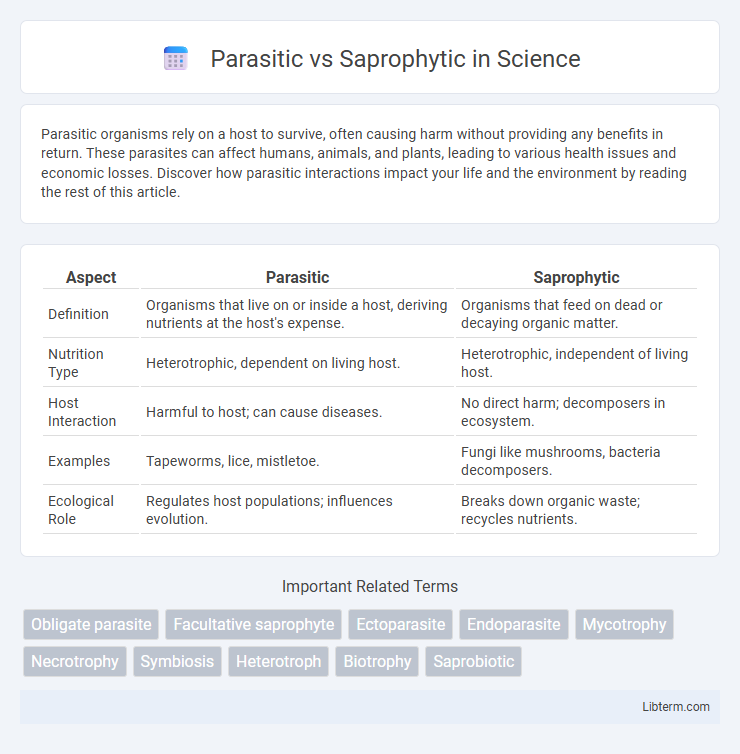Parasitic organisms rely on a host to survive, often causing harm without providing any benefits in return. These parasites can affect humans, animals, and plants, leading to various health issues and economic losses. Discover how parasitic interactions impact your life and the environment by reading the rest of this article.
Table of Comparison
| Aspect | Parasitic | Saprophytic |
|---|---|---|
| Definition | Organisms that live on or inside a host, deriving nutrients at the host's expense. | Organisms that feed on dead or decaying organic matter. |
| Nutrition Type | Heterotrophic, dependent on living host. | Heterotrophic, independent of living host. |
| Host Interaction | Harmful to host; can cause diseases. | No direct harm; decomposers in ecosystem. |
| Examples | Tapeworms, lice, mistletoe. | Fungi like mushrooms, bacteria decomposers. |
| Ecological Role | Regulates host populations; influences evolution. | Breaks down organic waste; recycles nutrients. |
Introduction to Parasitic and Saprophytic Organisms
Parasitic organisms obtain nutrients by living on or inside a host, often causing harm, while saprophytic organisms derive nourishment from decomposing organic matter, playing a critical role in nutrient recycling. Parasitic species include bacteria, fungi, and protozoa that depend on living hosts for survival, whereas saprophytes such as fungi and bacteria thrive on dead or decaying tissues. Understanding these two modes of nutrition highlights their ecological significance in maintaining ecosystem balance through interactions with living and non-living organic materials.
Defining Parasitism: Key Characteristics
Parasitism is a biological relationship where one organism, the parasite, benefits at the expense of the host organism by deriving nutrients directly from it, often causing harm. Key characteristics include the parasite's dependence on the host for survival, specialization in attachment or invasion mechanisms, and a negative impact on the host's health or fitness. Unlike saprophytes that feed on dead or decaying matter, parasites exploit living hosts, establishing a complex interaction involving host immune responses and parasite adaptation strategies.
Exploring Saprophytism: Essential Features
Saprophytism involves organisms that obtain nutrients by decomposing dead organic matter, playing a crucial role in nutrient cycling and soil fertility. These saprophytes secrete enzymes to break down complex organic compounds into simpler substances, facilitating biodegradation. Unlike parasitic organisms that rely on living hosts, saprophytes thrive independently on non-living matter, contributing significantly to ecosystem balance.
Differences in Nutritional Strategies
Parasitic organisms obtain nutrients by living on or inside a living host, deriving sustenance at the host's expense and often causing harm. Saprophytic organisms, such as fungi and bacteria, acquire nutrients by decomposing dead organic matter, recycling nutrients back into the ecosystem. The key difference lies in parasitism's dependency on a living host versus saprophytism's reliance on non-living organic material.
Ecological Roles and Significance
Parasitic organisms derive nutrients directly from living hosts, often causing harm, thereby influencing host population dynamics and maintaining ecological balance by preventing overpopulation. Saprophytic organisms decompose dead organic matter, recycling nutrients back into ecosystems and supporting soil fertility and plant growth. Both modes of nutrition are crucial for ecosystem functioning, with parasites regulating species interactions and saprophytes driving decomposition and nutrient cycling.
Adaptations of Parasitic Organisms
Parasitic organisms exhibit specialized adaptations such as haustoria for extracting nutrients directly from host tissues and reduced or absent photosynthetic structures due to their reliance on host-derived sustenance. They possess complex attachment mechanisms like suckers, hooks, or adhesive secretions to firmly anchor onto hosts, ensuring prolonged access to resources. Enhanced evasion strategies, including secretion of immunosuppressive agents, enable parasites to avoid host immune responses and maintain infection.
Adaptations of Saprophytic Organisms
Saprophytic organisms exhibit specialized adaptations such as the secretion of extracellular enzymes to efficiently decompose complex organic materials in dead or decaying matter. Their extensive hyphal networks enhance nutrient absorption by increasing surface area, allowing rapid colonization of substrates rich in cellulose and lignin. These adaptations enable saprophytes to play a critical role in nutrient cycling and ecosystem sustainability by breaking down organic waste into simpler compounds.
Examples of Parasitic Species
Examples of parasitic species include Plasmodium, the protozoan responsible for malaria, and the parasitic tapeworm Taenia solium, which infects the intestines of humans. Parasitic fungi like *Candida albicans* cause infections by drawing nutrients from their hosts, often leading to diseases. In contrast, saprophytic organisms such as *Penicillium* species derive nutrients from decomposing organic matter, playing a crucial role in nutrient recycling.
Examples of Saprophytic Species
Saprophytic species obtain nutrients by decomposing dead organic matter, playing a crucial role in nutrient cycling within ecosystems. Examples of saprophytic fungi include *Penicillium*, known for antibiotic production, *Aspergillus*, important in industrial fermentations, and *Rhizopus*, commonly seen on decaying bread. These organisms break down complex organic materials into simpler substances, facilitating soil fertility and ecosystem sustainability.
Impact on Ecosystems and Human Life
Parasitic organisms extract nutrients from living hosts, often causing diseases that disrupt ecosystem balance and threaten agricultural productivity, leading to economic losses and health risks in human populations. Saprophytic organisms decompose dead organic matter, recycling nutrients and maintaining soil fertility, which supports plant growth and sustains food chains critical for ecosystem stability and human agriculture. The contrasting roles of parasitic and saprophytic species underscore their significant, yet distinct, impacts on ecosystem dynamics and human well-being.
Parasitic Infographic

 libterm.com
libterm.com